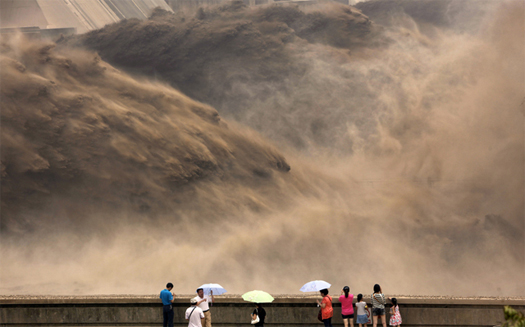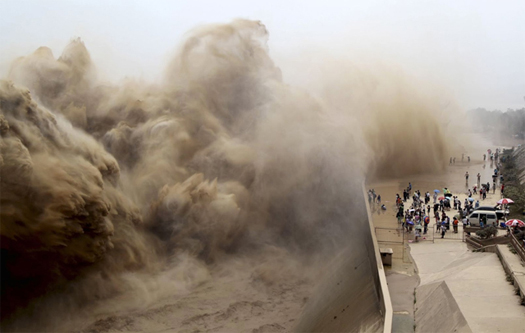

[The annual sediment release procedure at Xiaolangdi Dam on the Yellow River in Henan province, China. According to the Daily Mail, “this annual operation sees more than 30 million tonnes of silt sent downstream a year, with more than 390 million tonnes shifted this way over the last 13 years”.
It is noteworthy, from the perspective of the landscape architect, that this sediment release has become a public spectacle and yearly ritual for local citizens, as the Daily Mail also notes that “residents turn out to watch the annual event — and try to avoid a drenching by protecting themselves with umbrellas”. The Chinese Sedimentary Sublime, to bastardize David Nye. The scale of our geologic agency, made tangible by the compression of a full year of accelerated erosion into a tiny window of time and space (much like the recent removal of the Condit Dam in Washington state, which Brett Milligan has written about, though that was a private spectacle and involved much more than a year of stored sediment).
Meanwhile, the Mississippi River Delta is shrinking and starved of sediment, much of which is trapped behind dams far upstream, as geographer Richard Campanella noted in Places earlier this year:
“…many of our major river systems find themselves with too much sediment where we don’t want it, and too little where we desperately need it. Six major reservoirs constructed in the mid-20th century on the Missouri River, which historically transported 320,000,000 tons of suspended sediment annually to the Gulf Coast, now impound over three-quarters of that load behind their dams, where it reduces reservoir storage capacity and necessitates costly removal. On the downstream side of the dams, the unnaturally clear and swift-moving current (what hydrologists term “hungry water”) incises the channel and scrapes clean the banks of the carbon-rich fine-grain material needed for healthy fisheries. Similarly, eight locks and dams built between the 1870s and 1930s have converted what used to be the free-flowing Illinois River into a series of placid “pools” connected by mere trickles. The slowing of water therein has caused sediments to settle and fill backwater lakes and side channels, diminishing ecological productivity and recreational uses while increasing dredging costs for navigation. Similar scenarios occur on the Arkansas, Tennessee, and Upper Mississippi branches — indeed, on nearly every major river system nationwide.“
Campanella’s full article — which culminates in an extremely intriguing proposal to alter the patterns of deposition for material dredged from the Mississippi River and release this trapped sediment via legal tactics — can be read here; mammoth discussed the six dams and six reservoirs of the Missouri River a couple years ago.
The sediment release photographs are from DDN Japan via a tweet by Jonathan Solomon.]

